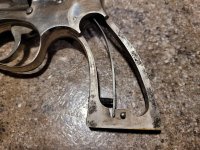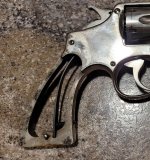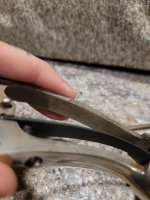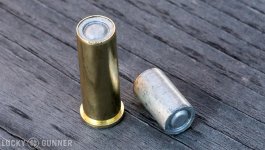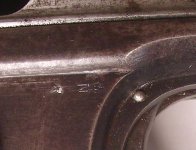The bottom line of all this is what you already said, "----------I'm pretty happy to add it."
That says it all, and that's all that counts.
And then, as usual, I'm compelled to utter a few words about the cautions of shooting +P ammo in it.
1. The best reason to stay away from + P is the price---can you say "rip-off"?
2. The next, and my favorite, is the +P hype doesn't track with FACTS!
Here's just one set:
The muzzle velocity of the 158 grain bullet load from 1925 is 858 feet per second. This from S&W's catalog of the time.
The muzzle velocity of today's 158 grain bullet load is 755 feet per second. This from the tables published in the Gun Digest.
Then there's the muzzle velocity of today's +P 158 grain bullet load some of the folks are cautioning you about using (also from the Gun Digest tables)----890 feet per second. I reckon you can see why they're concerned----or then again, maybe not.
I've wondered about the whys and wherefores of +P from time to time, and came up with this illustrative tale:
The scene is the conference room of any ammo manufacturer. The guy from the corner office is asking for input on how to increase the profit margin. A bright eyed, bushy tailed kid who doesn't yet know the first thing about the business sticks his hand up in the air, and waves it frantically----calling out "I KNOW---I KNOW!!"
Nobody laughs out loud, but there are more than a few stifled snickers from around the table. The Boss Man knows better than to shut the kid down, and gives him the go-ahead.
The Kid says, "How about this?!! We increase the loads back to about what they used to be, give them a catchy name, and charge more for them."
Nobody says a word----except for the Boss Man. He says, "I sure am glad I thought of that! How'd you like to have lunch with me in the Executive Dining Room, and we can talk more about it?"
The Kid was promoted to Executive Vice President a week later, and they all lived happily ever after---all except for those who snickered at him when he was waving his hand and hollering I KNOW--I KNOW. Those folks were tossed out on their butts by the new Executive Vice President.
Ralph Tremaine
That says it all, and that's all that counts.
And then, as usual, I'm compelled to utter a few words about the cautions of shooting +P ammo in it.
1. The best reason to stay away from + P is the price---can you say "rip-off"?
2. The next, and my favorite, is the +P hype doesn't track with FACTS!
Here's just one set:
The muzzle velocity of the 158 grain bullet load from 1925 is 858 feet per second. This from S&W's catalog of the time.
The muzzle velocity of today's 158 grain bullet load is 755 feet per second. This from the tables published in the Gun Digest.
Then there's the muzzle velocity of today's +P 158 grain bullet load some of the folks are cautioning you about using (also from the Gun Digest tables)----890 feet per second. I reckon you can see why they're concerned----or then again, maybe not.
I've wondered about the whys and wherefores of +P from time to time, and came up with this illustrative tale:
The scene is the conference room of any ammo manufacturer. The guy from the corner office is asking for input on how to increase the profit margin. A bright eyed, bushy tailed kid who doesn't yet know the first thing about the business sticks his hand up in the air, and waves it frantically----calling out "I KNOW---I KNOW!!"
Nobody laughs out loud, but there are more than a few stifled snickers from around the table. The Boss Man knows better than to shut the kid down, and gives him the go-ahead.
The Kid says, "How about this?!! We increase the loads back to about what they used to be, give them a catchy name, and charge more for them."
Nobody says a word----except for the Boss Man. He says, "I sure am glad I thought of that! How'd you like to have lunch with me in the Executive Dining Room, and we can talk more about it?"
The Kid was promoted to Executive Vice President a week later, and they all lived happily ever after---all except for those who snickered at him when he was waving his hand and hollering I KNOW--I KNOW. Those folks were tossed out on their butts by the new Executive Vice President.
Ralph Tremaine
Last edited:

